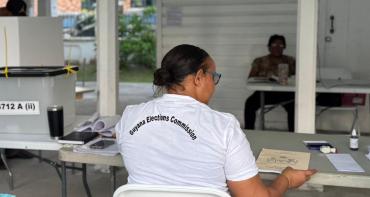
Use the links below to navigate to short abstracts of each article, with options to read the full abstract or download the full article as a PDF.
Contents
- Editorial
Nkechi Amobi and Aidan Ferguson - The Emerging Artificial Intelligence Legal-Judicial System’s Interface: Assessing the State of Nigeria’s Judicial System’s Readiness for a Revolution
Olalekan A. Bello and Cecile Ogufere - Legal Application of Technical and Procedural Standards and Frameworks in the Combat Against GAI-Powered Cybercrime
Gilberto Martins de Almeida, Fernando Bourguy, João Farrel and Diego Semeraro - Violent Extremism and Artificial Intelligence: A Double-Edged Sword in the Content of ASEAN
Wan Rosalili Wan Rosli - AI Systems and the Future of Intellectual Property Regimes
Teresia Munywoki - Crimes of Influence: Generative Artificial Intelligence-led Crime as a Service
Nicole Matejic and Chris Wilson - Ensuring a Secure Future by Insuring Against Cybercrime
Eric Cho and Serene Chan - The National Security Exception in International Trade and Cybersecurity
Kartikeya Garg - Cybercrime in the Asia-Pacific Region: A Case Study of Commonwealth APAC Countries
Olajide O. Oyadeyi, Oluwadamilola Adeola Oyadeyi and Rofiat Omolola Bello - Towards a Victim-Centred Approach? Reflections on Existing Cybercrime Instruments and the Draft United Nations Convention on Cybercrime
Brenda Mwale
Editorial
Nkechi Amobi and Aidan Ferguson
Short abstracts
The Emerging Artificial Intelligence Legal-Judicial System’s Interface: Assessing the State of Nigeria’s Judicial System’s Readiness for a Revolution
Olalekan A. Bello and Cecile Ogufere
This article analyses how AI is revolutionising various sectors, including the legal-judicial system. It highlights how AI can be used to predict case outcomes, streamline contract review processes, save time and resources for legal professionals and assist judges in making more informed decisions. Despite its potential benefits, the article notes that Nigeria’s judicial system faces numerous challenges that may hinder its readiness for an AI revolution. It also focuses on how that system can draw insights from the emerging global frameworks to establish its own regulations to implement AI technologies, safeguard the rights of citizens and ensure fair and unbiased decision-making processes.
Legal Application of Technical and Procedural Standards and Frameworks in the Combat Against GAI-Powered Cybercrime
Gilberto Martins de Almeida, Fernando Bourguy, João Farrel and Diego Semeraro
Acknowledging that GAI has deepened the gap between fast-changing innovative cyberattacks and the slow pace of legislative processes, the authors argue that to mitigate the resultant exposure, states should look for ways to address this gap. One option to be considered is resorting to standards, which may provide faster adoption, more specific focuses and international recognition. This is particularly valid for the Commonwealth’s small states, whose structures may not be as resourceful as those of larger states. In summary, the article analyses the convenience of building effective supplementation and constant updates by and between standards and legal rules, referring to several published standards which could be helpful for the prevention of GAI-powered cybercrime.
Violent Extremism and Artificial Intelligence: A Double-Edged Sword in the Content of ASEAN
Wan Rosalili Wan Rosli
This paper advances the argument that cyberspace has created a new haven from which terrorist organisations can carry out terrorist activities, which has resulted in unprecedented transnational extremism and extremist networking. The emergence of new technologies such as AI has also provided a new sandbox in which insurgents can spread their propaganda. Wan Rosli provides a discussion on the duality effect of AI in countering violent extremism within ASEAN by highlighting the risks and vulnerabilities attached to the deployment of such technologies, and sheds light on both how such technologies can be misused and how ASEAN states can respond to the risks associated with AI.
AI Systems and the Future of Intellectual Property Regimes
Teresia Munywoki
In this exploration of the relationship between AI and intellectual property rights (IPR), the author highlights the challenges and opportunities that arise from their intersection, and posits that given AI’s pervasive influence across various sectors, questions surrounding authorship, ownership and protection of AI-generated innovations have emerged. The discussion spans patent law, copyright issues and ethical issues, highlighting the need for a balanced approach that fosters innovation while safeguarding the rights of all stakeholders. The legal dilemmas that the author highlights, such as determining inventorship for AI-generated inventions and attributing copyright for AI-created content, underscore the complexity of this evolving landscape.
Crimes of Influence: Generative Artificial Intelligence-led Crime as a Service
Nicole Matejic and Chris Wilson
The authors advance the idea that crimes of influence are crimes that seek to influence people towards harmful outcomes, and will be a defining feature of generative AI-led cybercrime. While the technology itself is a regular feature of contemporary discussion and research, less thought has been given to the ways in which generative AI (GAI) impacts human cognition to create increasingly permissive environments in which cybercriminals and terrorists can operate.
Ensuring a Secure Future by Insuring Against Cybercrime
Eric Cho and Serene Chan
Given rapid advancements in technology and digitalisation, cybercrime has emerged as a formidable threat capable of disrupting business operations and causing financial impacts across society. The authors of this paper note that in recent years, insurance has become a method of transferring such risks from businesses and individuals to third-party entities, offering a sense of reassurance and protection. Acknowledging the limitations of the private insurance sector, theyadvocate for collaborative efforts between public and private entities to address the multifaceted challenges posed by cyber risks in effective ways.
The National Security Exception in International Trade and Cybersecurity
Kartikeya Garg
International trade and cybersecurity are becoming increasingly interconnected, with countries implementing various digital technologies to facilitate cross-border trade in goods, services and information. To regulate this, countries could adopt various cybersecurity policies such as data localisation, export controls and import restrictions; however, these may be trade-restrictive and violate World Trade Organisation (WTO) law. This paper discusses the evolution of the national security exception within the WTO and other FTAs, historically used for protection against traditional security attacks, to determine whether existing treaty formulations can extend to cybersecurity measures.
Cybercrime in the Asia-Pacific Region: A Case Study of Commonwealth APAC Countries
Olajide O. Oyadeyi, Oluwadamilola Adeola Oyadeyi and Rofiat Omolola Bello
The digital transformation in the Asia-Pacific (APAC) region, coupled with its expanding economic activities and online presence, has made it a prime target for cybercrime: according to projections, the region faces a potential cost of roughly US$3.3 trillion from cybercrime by 2025. In this paper, the authors discuss the context behind cybercrime in the APAC region, particularly its post-COVID proliferation; the pros and cons of the potential use of AI in cybersecurity; cybersecurity initiatives and strategies in the Commonwealth APAC region; and options for policy consideration.
Towards a Victim-Centred Approach? Reflections on Existing Cybercrime Instruments and the Draft United Nations Convention on Cybercrime
Brenda Mwale
This article advances the argument that punishing offenders through a retributive approach is often not sufficient to address the plight of victims of cybercrime, given the unique impact that such crimes can have. Having examined the extent to which existing cybercrime instruments, and the draft UN Convention on Cybercrime, address victims’ needs, the author argues that legal approaches to addressing cybercrime should adopt a victim-centred approach that offers them adequate safeguards to protect them, and human rights guarantees.



